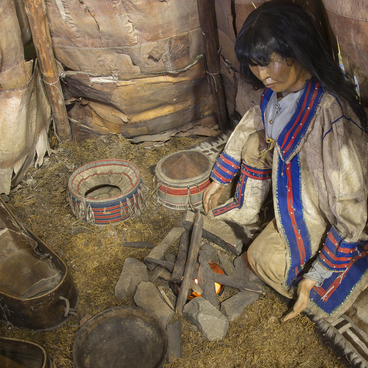In the Transbaikal Regional Museum of Local Lore visitors can see how one of the most common Evenk rituals — the rite of obtaining hunting luck — was performed. It was called “sinkelaun” in the Evenki language. Usually, the ritual was performed once a year, in the first half of October, when the hunting season in the region began.
The rite was an important tribal celebration in which Evenk men and a shaman took part. They gathered in the forest at a predetermined place and set up camp and the shaman’s yurt.
The ritual required a lot of preparations and included four parts. First, the hunters made necessary ritual attributes: figurines of cloven-hooved animals which inhabited the taiga and served as bait. They were made from tree and bush twigs that the animals ate. The figures were then arranged in the forest.
The next stage began three days later. During this time, the men lived in the camp, rested, trained their younger hunters, and planned their future hunts. On the third day, after sunset, the ritual of feeding the fire — communicating with spirits — was performed in the shaman’s yurt.
The shaman, sitting in the center of the dwelling, arranged figurines of wooden birds in a circle: an eagle, swans, and ducks. The figures symbolized the spirits that accompanied the ritual. The shaman slowly danced, beat the tambourine, sang, and prayed to send good fortune and animals to the hunters. The assistants threw around pieces of woolen fabrics which symbolized the souls of the animals. The shaman collected them and returned with the “prey”.
After feeding the fire, the hunters put on shamanic attributes in turns and beat the tambourine. Thus, they saw off the spirits that helped in the rite back to their world.
The next morning, after sunrise, the third part of the ritual began — the hunters were cleansed from hostile and evil spirits. To the shaman’s songs and dances, the men walked through a chichipkan: the hunters standing in pairs one after the other formed a corridor, they held juniper or wild rosemary in their hands and waived.
Lastly, all of them returned to the yurt and repeated the rituals of sending-off the spirits. On this very day, the participants imitated the beyunkan — a sacred hunt for cloven-hoofed animal figures which they had previously placed in the taiga. They snuck on the dummies with a bow in their hands, shot at them, and then cut up carcasses made of twigs as if they were real beasts. The rite ended with songs and dances, all people returned to the camp and were ready to start the hunt.
The rite was an important tribal celebration in which Evenk men and a shaman took part. They gathered in the forest at a predetermined place and set up camp and the shaman’s yurt.
The ritual required a lot of preparations and included four parts. First, the hunters made necessary ritual attributes: figurines of cloven-hooved animals which inhabited the taiga and served as bait. They were made from tree and bush twigs that the animals ate. The figures were then arranged in the forest.
The next stage began three days later. During this time, the men lived in the camp, rested, trained their younger hunters, and planned their future hunts. On the third day, after sunset, the ritual of feeding the fire — communicating with spirits — was performed in the shaman’s yurt.
The shaman, sitting in the center of the dwelling, arranged figurines of wooden birds in a circle: an eagle, swans, and ducks. The figures symbolized the spirits that accompanied the ritual. The shaman slowly danced, beat the tambourine, sang, and prayed to send good fortune and animals to the hunters. The assistants threw around pieces of woolen fabrics which symbolized the souls of the animals. The shaman collected them and returned with the “prey”.
After feeding the fire, the hunters put on shamanic attributes in turns and beat the tambourine. Thus, they saw off the spirits that helped in the rite back to their world.
The next morning, after sunrise, the third part of the ritual began — the hunters were cleansed from hostile and evil spirits. To the shaman’s songs and dances, the men walked through a chichipkan: the hunters standing in pairs one after the other formed a corridor, they held juniper or wild rosemary in their hands and waived.
Lastly, all of them returned to the yurt and repeated the rituals of sending-off the spirits. On this very day, the participants imitated the beyunkan — a sacred hunt for cloven-hoofed animal figures which they had previously placed in the taiga. They snuck on the dummies with a bow in their hands, shot at them, and then cut up carcasses made of twigs as if they were real beasts. The rite ended with songs and dances, all people returned to the camp and were ready to start the hunt.



